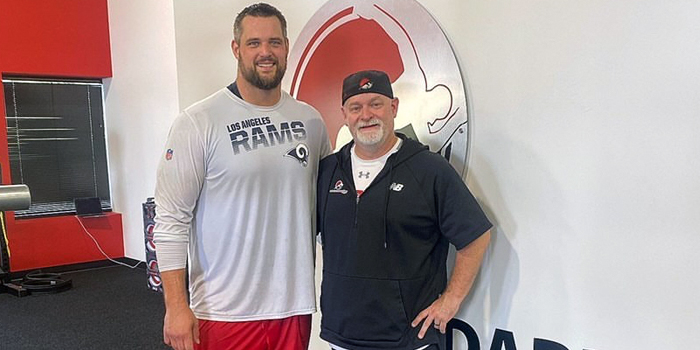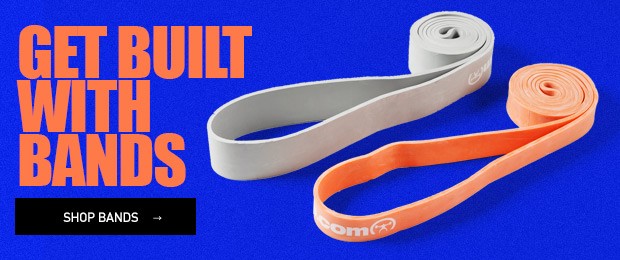
With football season upon us, I thought it would be a great time to share how Coach Brian Bott uses the conjugate method for football athletes. Most of you are familiar with the conjugate method. And, most of you agree that it WORKS. Interestingly, within most collegiate settings, a basic linear progression template is run. Not that linear progression templates don't work—Brian just found the conjugate method to work better.
Brian Bott has been a strength and conditioning coach in various capacities for almost 25 years. He earned his master's degree at the University of North Dakota, then served as an assistant strength coach for the University of Wisconsin football program from 2000-2013. Brian was a member of three Big Ten Championships and went to 11 bowl games, including three Rose Bowls. In 2014, Brian opened Sports Advantedge in Verona, Wisconsin. Since then, Sports Advantedge has expanded to open two more facilities at Beaver Dam and Waunakee. They partner with various high schools, including Beaver Dam, Wayland Academy, Wisconsin Dells, Madison Edgewood, and Sun Prairie Football. In his career, Bott has trained some of the best football players EVER TO play the game, including Joe Thomas, Russell Wilson, JJ Watt, and Travis Frederick.
How did you use the conjugate system at Wisconsin?
When I was at Wisconsin, I was given the task of training the offensive line, tight ends, fullbacks, quarterbacks, and specialists starting in the spring of 2010. This was a new concept to have certain position groups assigned off the main programs. As we started in the spring, I always followed and researched the conjugate system and the principles to make the system work. Now I had a chance to utilize it. We utilized the system starting in the summer. We utilized Monday as our max effort upper day, Tuesday was dynamic lower, Wednesday was a position day and recovery, Thursday was dynamic effort upper, and Friday was our max effort lower. Ideally, I would change quite a bit about this layout:
- We strictly used chains as accommodating resistance. At my gyms we use probably 70/30 bands and chains for any accommodating resistance.
- We would use sled drags in the program, especially recovery days, for more GPP.
- For the college scenario, we also had team runs to contend with. In my gyms, we 100% control volume, work load, and other stress on the body.
- We would add a lot more variation in the winter and summer to max effort movements—more pulls as well.How did you use the Conjugate system In-season?
How did you use the conjugate system in-season?
The in-season is where the conjugate system, in my opinion, is THE BEST FIT. Never add new stimulus the athletes haven’t already been performing in the summer. The in-season IS NOT the time to TRY new progressions, new exercises, or anything else that could add unknown stress to the athlete. So, I had to find a way to run essentially my summer program in the in-season. I am not a believer in linear periodization in-season as VOLUME destroys athletes in major movements in-season. I also DO NOT believe athletes, especially football players, can handle near max loads every week in the same movement.
So how do we continue the summer program yet not destroy the athletes in-season? Break summer training week into two weeks. We did this in four-week waves.
Sunday-Shake Out Lift
- Requirements before lift: Drink (2) 20 oz bottles of water
- Sled drags
- Over 100 reps of rows and vertical pulls
- Over 150 reps a varying hamstring movements light and with bands
- Arms for fun/light should raises
- Post-workout: Drink another 2 bottles of 20oz water
Monday/ Tuesday-Main Lift day
Lower body power movements: Jumps-Pulls
Week 1
- Max effort lower singles or doubles
- Combo with upper body pulls between sets
- Dynamic bench work: 8-12 sets combo with med ball contrast
- Hamstring work and neck work
- Cold tub post practice
Week 2
- Max effort upper singles or doubles
- Combo with hamstring variations
- Dynamic squat work: 8-12 sets
- Finish with upper body pulls and rows and neck
- Cold tub post practice
Week 3
- Max effort lower singles: Auto regulate
- Combo with upper body pulls between sets
- Dynamic bench work: 8-12 sets combo with med ball contrast
- Hamstring work and neck work
- Cold tub post practice
Week 4
- Max Effort Upper Singles: Auto regulate
- Combo with hamstring variations
- Dynamic squat work: 8-12 sets
- Finish with upper body pulls, rows, and neck
- Cold tub post practice
Thursday-Mobility
- More upper body pulls/shoulder and light hamstring work
- Hot cold contrast after the lift
What were some results?
I have seen some crazy results but nothing like what we were able to accomplish. We had guys PR in weeks 11 and 12 of the regular season. The goal is to win a championship, so the need for an athlete to be his best in the last weeks of the season is paramount. Hitting a PR in the squat may not seem that hard, but for offensive linemen to do it based on so many variables is amazing. We did not bust them up with volume early. Instead, we kept the loads high and their speed work fast and we offset what was being done volume-wise at practice in the weight room. We pressed once a week, essentially squatted once a week, and then built volume around the posterior chain. Finally, we had very few injuries and virtually no soft tissue injuries.
What advice would you give to coaches unfamiliar with the system?
That's easy! Read! Listen to podcasts. Watch videos. Call people who have had success. Call me. You will find most people who are passionate about helping others reach their goals don’t have secrets. Also, don’t try and make something up to try and be creative. Methods in strength and conditioning that work, work for a reason. Follow the basic guidelines! Ask for help. I remember when I was trying to figure some things out I always asked people for help. Also, find two to four people you can call at any hour of the day and ask a question to.
Any Future Plans?
We are always looking to add locations and bring our brand to others. Me personally, I love to educate. I have nearly 25 years in the field and have seen a lot. New on the plate is high school clinics, as well as our “Get Your Edge Podcast” on Apple and Spotify. I run this podcast with Kimberly High School strength coach Dean Matsche. Dean is my go-to for any questions I may have. Our podcast educates both athletes and coaches! I'd love to collaborate with our coaches for clinics and seminars as well. Again, I have no secrets—I just love helping athletes and coaches!
Thanks a ton to Coach Bott for taking the time to share this information. Hopefully, it has opened up your eyes as it has mine. This is some great information for strength and conditioning who looks over the football teams. Hope to see you soon!
As a top-ranked super-heavyweight, Chris Janek earned the nickname “Tank.” As a two-time all-state wrestler as well as an all-state, third team all-American football player he received multiple full-ride scholarship offers, choosing to play football for the University of Wisconsin. During his collegiate football career, Janek was a four-year letter winner as well as a two-year starter. He was part of four Bowl Games (two Rose Bowls, in which they won). After college, he furthered his football career with a tryout with the Cleveland Browns and an eight-year career in the now-defunct Arena Football League. He is the owner of Tanks Training Facility in Granite City, Illinois and has devoted himself to multi-ply powerlifting. In 2010, Janek totaled 2660 to win best lifter at the GPC Worlds (in Prague). In 2014, he won first place and best lifter overall at the XPC Finals with a 2725 total.










